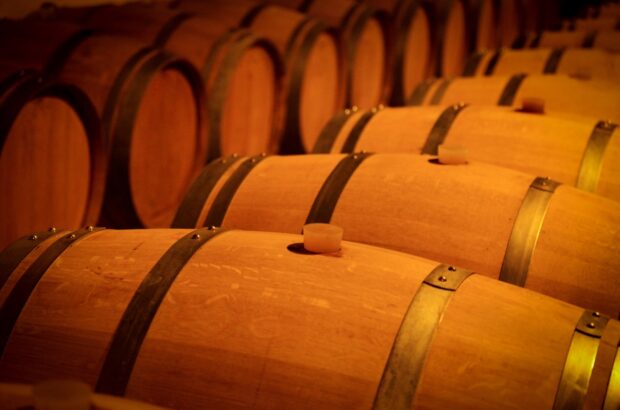The term ‘small but mighty’ could have been coined to describe Tasmania, at least in terms of its winemaking prowess. With just over 26,000 square miles of land to its name and a mere 2,000 hectares of vineyard plantings, the state could so easily be overshadowed by the vast Australian mainland to its north.
But take a close look at the results from the Decanter World Wine Awards (DWWA) judging in May and it seems that Tasmania’s day in the (albeit cooler-climate) sun has arrived.
The 2024 results for Tasmania were outstanding with two Best in Show awards, three Platinum medals and four Golds. Before this year, no Tasmanian wine had been garlanded as Best in Show since the Awards’ inception in 2004. That performance is no mean feat, especially when you consider that only 50 wines earned this accolade in 2024 (just 0.28% of the total wines tasted).
Given its relatively diminutive proportions, Tasmania punches far above its weight. To put things into perspective, it has 160 licensed wine producers and some 230 vineyards (England, though twice the size of Tasmania and very much an ‘emerging’ wine country, has more than 1,000 vineyards).
Tasmania accounts for just under 1% of Australia’s total national vineyard acreage, yet it accounts for more than 4% of the total value. Those figures paint a picture of a region where quality is uppermost.
Chardonnay and Pinot Noir evidently thrive here: all the Tasmanian Best in Show, Platinum and Gold winners, both still and sparkling, are made from these varieties. Added to that, Tasmania is fortunate enough to have a relatively cool climate – and the winemaking expertise is first class, as these results show.
Regional Co-Chair Justin Knock MW sums up the state’s winemaking potential and reality, saying: ‘The prevailing climate and warm weather, plus a natural Australian appreciation of fruit and soft tannins, mean a predisposition towards full evolution in young wines can be common. Therefore, a lot of winemakers, commentators and buyers really appreciate it when Australian (and Tasmanian) wines show built-in restraint, coolness and complexity, freshness and latent potential alongside the gifted fruit expression and refined tannins we expect. It suggests strongly of development potential in bottle, which is an essential marker of truly fine wine on the global stage.’
Tuning into Pinot Noir
Pinot Noir accounts for just under half of the vines grown in Tasmania and this notoriously finicky grape has put down roots in what it seems to consider a hospitable home: both of the Best in Show awards went to (still) Pinot, a DWWA first.
Bay of Fires, Pinot Noir 2022 (97 points) is a pan-Tasmanian blend while Lowestoft, Single Vineyard Jacoben Pinot Noir, Derwent Valley 2022 (97 points) comes from a single plot in the Derwent Valley in the eastern half of the island, north of Hobart in the rain shadow of Mount Wellington.
On the topic of rain, it’s a myth that Tasmania has high rainfall across the island, asserts Stewart Byrne, winemaker at Bay of Fires. ‘Although the western half of the island experiences very high rainfalls, the wine growing regions are predominantly on the eastern half. These are dry, typically receiving 300-500mm of rainfall a year. Summer and autumn days are sunny and long, with cold nights. This results in a very long growing season.’ It is, he says, ‘an amazing place to grow Pinot Noir’ – though not without challenges.
‘There is a high level of risk growing vines in Tasmania. It is very common to experience severe spring frosts, and high winds during flowering – and constant pressure from the abundant wildlife. We [at Bay of Fires] have decided the best approach is to diversify the location of our vineyards around the state to minimise the risk of losing an entire vintage to smoke damage or extreme frost; this allows us to mitigate risk and produce consistent high-quality wines.’
It’s a very different winemaking approach at Lowestoft. Chief winemaker Liam McElhinney explains: ‘The 25-year-old Jacoben Vineyard sits on a south-facing slope on the banks of the Lower Derwent River in Hobart. It defies every ounce of conventional Southern Hemisphere viticultural theory, in that optimal vineyard exposure is north-facing. With that said, Jacoben is comfortable in its ‘coolness’ on every level. Perhaps it’s ahead of its time.’
The climate can be challenging, McElhinney agrees, but that’s what makes it exciting. ‘The soils on which we grow these grapes have been formed by these often-harsh seasons over millennia, and we are now seeing just how compelling Pinot Noir can be on these ancient sites. The climate is challenging, but in my very short time (five years) making Pinot Noir in Tasmania, each vintage has yielded Pinots of immense charm, purity and excitement that I’ve not seen anywhere else in my 25 years as a winemaker.’
Sparkling success
Tasmania puts much of its Pinot and Chardonnay to excellent use with its sparkling wines, which in the 2023 vintage accounted for 38% of all wine produced in the state. About three quarters of Tasmania’s Chardonnay and just under half of its Pinot Noir are used to make sparkling wine.
Two of this year’s Platinum awards went to sparklers from a single producer: House of Arras, Blanc de Blancs 2014 (97 points) and House of Arras, Grand Vintage 2015 (97 points). Legendary chief winemaker Ed Carr has been masterminding sparkling wines here since the winery’s inception in 1995.
Of the Platinum winners, Carr says: ‘The Chardonnay selection for the Blanc de Blancs favours the most refined component options and their ability to meld as a single wine; the aim is to reflect the purity of the highest quality Tasmanian Chardonnay. The component selections for the Grand vintage blend are the more robust wines that will most critically combine to form an absolutely seamless palate.’
Fittingly, ‘arras’ is a French-derived word meaning ‘rich tapestry’; House of Arras wines are made with fruit from six Tasmanian regions with varying terroir – inland, coastal, and balancing warmer, drier areas with wetter, cooler areas. Carr explains: ‘We were always attracted to Tasmania as it is the most southerly of the Australian landmass and has a very cool maritime climate, and early winemaking pioneers had made some very exciting styles. Ultimately the test was to make sparkling wines in our own style from many regions to establish how the individual terroir from these sites suited our winemaking concept. We have since further evolved the vineyard resources to include all the recognised viticultural sub regions of Tasmania.’ It’s an approach that evidently works.
Tasmania’s third Platinum award went to a still wine – another from Derwent Valley: Dawson James, Chardonnay, Derwent Valley 2020 (97 points). After Pinot, Chardonnay is Tasmania’s second most-widely planted variety, accounting for 25% of tonnage. This example was deemed, “Seriously age-worthy with a moreish tang of texture on the impeccable finish” by the tasting panel.
Looking to the future
The winemaking future in Tasmania looks bright. According to government predictions, Tasmania’s climate is not predicted to change as rapidly as other Australian regions and the forecast temperature changes are not likely to impact significantly on the state’s suitability for grape-growing. Unlike many other parts of the winemaking globe, availability of water is not as problematic here as elsewhere (Tasmania receives 13% of Australia’s annual rainfall run-off). And it’s phylloxera-free.
Knock believes that Tasmanian wine producers are now hitting their stride.
‘Tasmania has been emerging as a fine region for Pinot Noir for some time,’ he says. ‘I think there was a long period of ‘high potential’, let’s say from the 1980s until maybe the late 2000s, when vineyards were young and many wines were made in a small number of custom wineries and perhaps converged a bit in style. In the last 10-15 years, we’ve seen a blossoming of vine age, deeper investment in winemaking facilities and a richer sense of stylistic interpretation, so that there is now a truly varied range of wines emerging.’
Tasmania’s viticultural history dates back to 1823 but it’s likely that its best days are yet to come.
DWWA 2024: Tasmania’s top-awarded wines to try
Sparkling
House of Arras, Blanc de Blancs 2014

97 Platinum
Sensational tiers of lime marmalade, orchard fruits and roasted pineapple with a whiff of sea spray which freshens and simpers. Silky and billowing with a gossamer mousse, gentle acidity and a gorgeous lemon curd finish. Alcohol 13%
House of Arras, Grand Vintage 2015

97 Platinum
Utterly delicious notes of lemon curd and green apple with a tapered mousse which flows delicately over the luminous acidity. Textured and generous with an unfolding bustle of citrus and quince parading enthusiastically towards the finish line. Alc 13.2%
Jansz, Late Disgorged Cuvée, Pipers River 2015

95 Gold
A triumphant nose of brioche, toasted nuts and honeyed stone fruits with a delectable creamy mousse and precise acidity. Delightfully mature with a delicate butterscotch finish. Alc 12.5%
White
Dawson James, Chardonnay, Derwent Valley 2020

97 Platinum
Oozing magnificence with its wonderful levels of honeyed fruit, super smart minerals and vibrant spice which cascade over the sleek, simmering acidity and luxuriously buttery consistency. Seriously age-worthy with a moreish tang of texture on the impeccable finish. Alc 12.5%
Dalrymple Vineyards, Single Site Pipers River Chardonnay, Pipers River 2021

96 Gold
Oodles of succulent red grapefruit, lemon and pear overlay a profile of textured oak and flinty minerals. Strikingly fresh and crunchy with a generous finish. Alc 13%
Red
Bay of Fires, Pinot Noir 2022

97 Best in Show
Prior to 2024, we’ve never had a Tasmanian Pinot in our Best In Show selection. This year we have two. Was it because 2022 was a sensational vintage? Not exactly – the east coast of the island suffered from a spectacularly cool, wet season; elsewhere on the island, though, conditions did indeed vary from good to outstanding. The first wine in our pair is a pan-Tasmanian blend with source fruit from several regions. It is a translucent dark red in colour, with warm, settled aromas of plum, cherry and raspberry just teased towards sweetness with subtle oak. It is warm, soft and mouthfilling, built on the same core of subtly mingled fruits with muted, natural acidity and fine tannins, the combination giving an almost silky charm to the wine. This considered, restrained winemaking lays the groundwork for a Pinot which is hugely easy to drink yet at the same time deeply satisfying and highly amenable – a Pinot to sip on its own, to chill with fish or to serve at a cool room temperature for white meats and salads. Alc 13.6%
Lowestoft, Single Vineyard Jacoben Pinot Noir, Derwent Valley 2022

97 Best in Show
The second of this year’s outstanding 2022 Tasmanian Pinot Noirs comes from the Derwent Valley, just to the north of Hobart and in the rain shadow of Mount Wellington. The region can be drought-susceptible in warm summers, but in the wetter season of 2022 its site stood it in good stead. This is a darker wine that its pan-Tasmanian peer, but beautifully crafted: singing red fruits without any shadowing from oak, and with the intrinsic grace and charm of the Derwent Valley’s fruit well to the fore. On the palate, it is pure, bright and mouthfilling, packed with juicy raspberry; both tannins and acids are soft and sustaining. They nourish and ease the gorgeous fruit core through the palate to a gently subsiding finish. There’s just a touch of tarry complexity behind those fruits. Virtuoso work from a Pinot region of extraordinary promise. Alc 13.5%
Eddystone Point, Pinot Noir 2022

95 Gold
Beautifully defined strawberry fruit with inflections of spice and tobacco leaf. Voluminous and charming with a succulent flow of tannin and acidity opening up with every mouthful. Alc 14.5%
Pressing Matters, Pinot Noir, Coal River Valley 2022

95 Gold
Delicate strawberry fruit enlivened by cracked black pepper and sour cherries with finely woven gossamer tannins and a wonderful freshness running throughout. A delightful treat! Alc 12.8%






